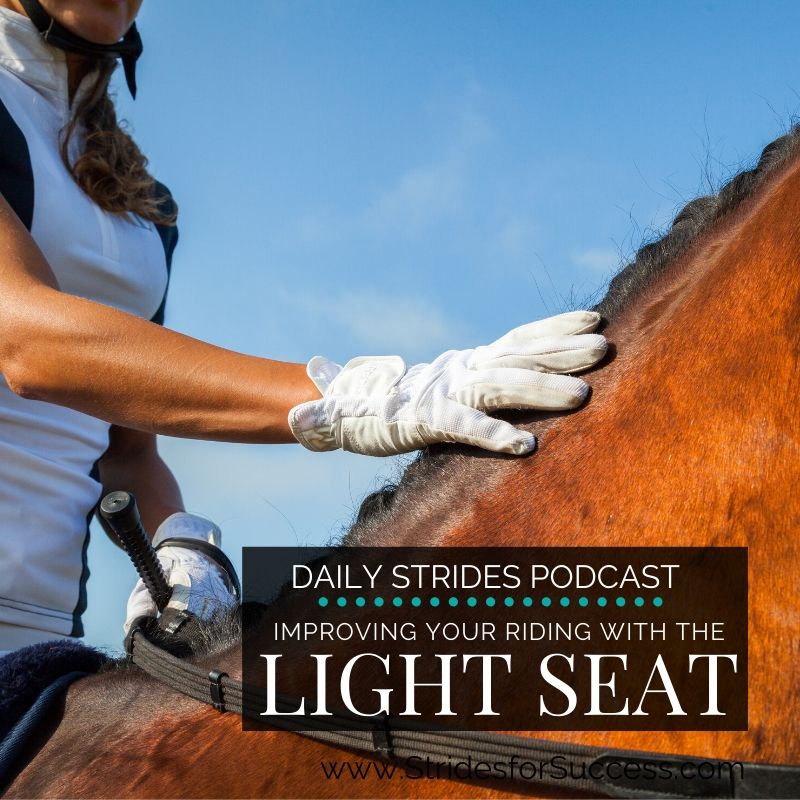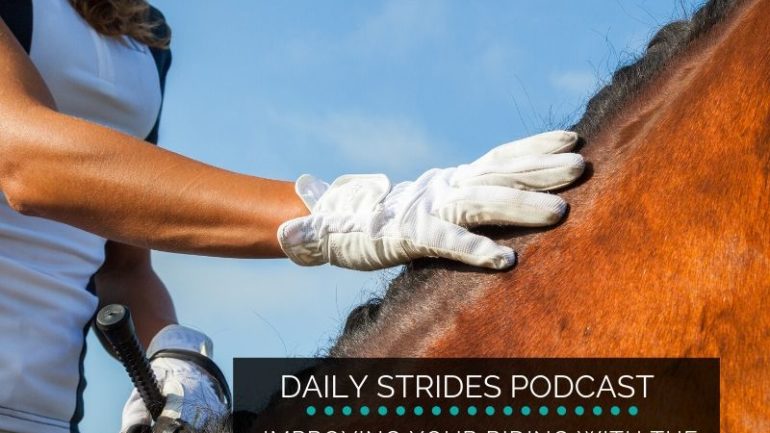
Have you ever considered how much you are either helping or hindering your horse when you’re riding? Do you wonder what you could do, today, to begin improving your influence in the saddle? Well, I am going to give you something fun to do in the saddle that will improve your riding – and put a smile on your face as well.
I want you to begin figuring out how independent you are in the saddle when riding. You are going to do this by riding the light seat or two-point seat. Your bum out of the saddle as you ride. Some lovely daylight between the arse of your trousers and the seat of your saddle.
I already know that many riders will have clicked away by now, but if you are still here; good on you! This exercise is for ALL riders. Improving your balance will always improve the overall conversation with your horse, regardless of the discipline that conversation occurs in.
What Is the Light Seat?
The light seat happens when you are riding. It involves you actually ‘standing’ on your own two feet while working your horse. It requires you to balance yourself. This means no leaning, holding on or crouching down on your horse’s neck, a neck strap or breastplate, or the pommel of the saddle. Also, no holding onto the mane.
Your stirrups will have to be short enough so that you can support your weight into your heels while having that all-important clearance between your bum and the saddle.
From here, you simply ride like you would normally do, but with your bum no longer putting weight on your horses back. There are varying degrees of how much ‘daylight’ you have between your bum and the saddle. However, I usually recommend a good amount of daylight when riders are starting off working in the light seat and this is due to it being a little more difficult to ‘cheat’ that way!
Why the Light Seat?
There are lots of reasons to use the light seat in your riding. Probably the most commonly used one is when cantering or galloping in open spaces. Sitting in your normal upright seat can get a little tiring and, well, bumpy! The light seat allows the horse to move underneath you – and allows you to enjoy the experience.
The light seat is also really useful when working over ground poles or small raised poles with your horse. It allows your horses back to engage, without the rider being heavy and working against it.
The light seat is also useful when you find yourself partnering with a horse who is feeling enthusiastic and excited about working! It lets the horse ‘work off’ some of the energy without fighting against him. It also allows the energy to flow out if necessary to dissipate any excess energy that the horse may be carrying.
Finally, the light seat is an excellent way to improve rider balance, fitness and overall coordination. It allows riders to ‘test’ themselves and their abilities in the saddle, and have fun while doing so.
Your Base of Support
So the first thing you want to do before you transition into the light seat is to make sure the weight is in your heels. You will be ‘standing’ on your heels in the light seat. In order for this to happen your lower leg must be underneath you. Not in front of you, or behind you.
Simply put, if I was with you in the arena and I clicked my fingers and made your horse vanish – you would land on your feet.
Your foot must also be correctly positioned in your stirrup. So many riders ‘square’ the iron with their foot. However, the iron must rather be diagonally under your foot. From the ball of your foot, diagonally across to the nail on your little toe is a good basic way of thinking about this. When your foot is correctly positioned in the stirrup, it allows your ankles, knees, and hips to become effective ‘shock absorbers’.
Put differently, correct stirrup placement allows you to move with the energy of your horse, rather than bouncing against it.
As you move in and out of the light seat, remember to continuously check and improve your base of support. Weight into your heels. Lower leg underneath you and foot correctly placed in the stirrup iron. If anyone of these three elements is missing or ‘off’, you will have problems with the light seat.
Lifting Your Bum Out of the Saddle.
The big moment. Liftoff! And for so many riders this is one of those ‘easier said than done’ moments! However, there are a few things you can do which will help make it easier for you. Firstly, think about engaging your core. Your abdominal muscles. Also, your back, both upper and lower.
For many riders, engaging their upper back becomes easier when they focus on opening their chest. Imagine if we held a measuring tape on your one shoulder and we wanted to measure the distance, across your chest, to your other shoulder. Make that distance as wide as you can by opening your chest. This will help you engage your upper back.
It will also help you to ‘open’ your arms, thereby becoming a whole lot clearer with your aids when communicating with your horse. Big deep breaths in and out. Feel the expansion in your chest area.
Straightening Your Back
When you engage your back, it will become more straight. This is important as it allows the energy to flow through your body. Many riders, when they initially transition into the light seat, ride with an almost C shape through their back. They curl their shoulders. Which effectively collapses their upper body.
When you focus on remaining engaged and straight through your back, you are committing to carrying yourself. Your own weight, your own arms and hands. It also allows you to carry your head – and focus on where you’re going.
If you are finding it difficult to straighten your back in the light seat, think about ‘sticking your bum out’ behind you. I know, it sounds so odd and, well, irrelevant. But trust me, if your back keeps going into full ‘hamster mode’ and curling or collapsing, sticking your bum out behind you will help engage your lower back.
When in the light seat, your lower back provides important support to your upper back. Your core is fully engaged and working in order to help you remain balanced and moving with your horse.
Independent Hands and Reins
The negative effect of ‘leaning on’ or using your horse’s neck for balance cannot be overstated here. in order to ride a true light seat, your hands and arms must be independent. This is so you can continue to engage in the contact with your horse.
There seems to be a misconception surrounding the light seat which many riders believe there is no contact when in it. This couldn’t be further from the truth…
Contact is just as important in the light seat as it is throughout the whole ride.
If your hands are touching anything except the leather of your two reins, you are leaning or depending on your horse for support. Also, be careful that you are not leaning on the reins themselves for support. You should be supporting you because you have a solid base. You should not be relying on your horse for your balance.
If you are struggling to balance, go back and reassess your base of support. Your heels, your lower leg and your foot in the stirrup. Then asses your back and shoulders. If they are all correct, you have a fitness issue – not a support issue!
What Should Your Hands Be Doing?
Your hands should be engaging in the conversation with your horse. They should be ready to establish the contact from the energy that is now flowing more freely through your horses back. This is where so many riders become confused with the light seat.
They believe that their horse will ‘take off’. Or that there is no real benefit because their horse is not working. However, I am going to challenge you to think a little differently about this.
You can do almost everything you can do in your normal ‘upright, from a good quality light seat.
But you MUST balance yourself first if your light seat is to become an effective tool in your riding. If you keep dropping your contact, every time you transition into the light seat, your horse won’t ‘work’ when you are in it. Couple this with the fact that the reason most riders are dropping the contact is that they are leaning on the horse’s neck.
One of the great things about the light seat is you allow your horse to truly engage his back, without hindrance from the rider. If you are leaning on his neck, this becomes impossible for the horse.
Leaning puts a whole human worth of extra weight on the area of your horses body you are actually asking him to lighten…
Transitioning In and Out of the Light Seat
You go in and then you go out… In and out… Out and in… This requires suppleness from the rider. Strenght to support themselves through the transition and then suppleness to allow the flow of energy while they ‘hold’ the position.
Practice moving in and out of your light seat while maintaining the contact and gently redistributing your weight.
You can also play with the amount of fold you are allowing through your hips. More ‘fold’ will result in your chest moving closer to your horse’s withers. Remember, your back will remain straight. Curling your back is very different from folding your hips!
Also, when working your horse, realize that you probably don’t need as much fold as you think in order to be effective. The light seat is so versatile, you can really experiment and see what suits you and your horse best.
Happy Riding
Lorna

